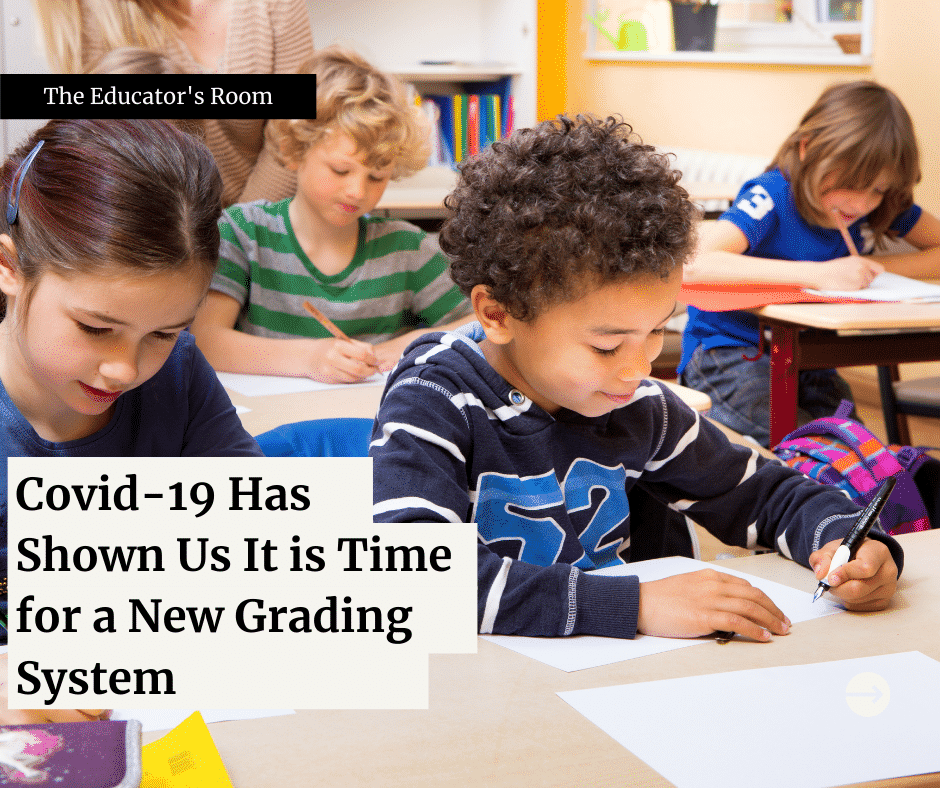By: Rachael Rudi
The Covid-19 pandemic has opened up the opportunity for change within the education system. From racial justice, to access to an internet connection, to whether or not homework is valid, we are witnessing a shift in how schools operate that will not fully return to “normal” once this pandemic ends. The buzzword these days is “new normal,” and this is something we will all need to get used to as change after a change occurs.
One more change we need to start thinking about is our grading system. As a middle school history teacher, I support moving away from a system that ranks students from perfect to failure, A to F. Our new circumstances are the perfect time to create something new that is equitable and empowering for all of our students.
Toward the end of the second marking period, I had 25 students failing my classes. I only have 95 students. A whole quarter of my student’s failing is unacceptable to me, and I know that, if we were learning in-person, I could better support the majority of these students and help them to earn a passing grade. A ranked letter grade system certainly does not work during remote learning; it does not truly work during in-person learning, either.
The History of the Letter Grade
How did letter grades even gain a place in our schools? According to an article by education resource TurnItIn, letter grades did not become common in schools until the 1940s. Even in the early 1970s, only about two-thirds of schools used this system. Of course, the rise of education for all occurred in the mid-1900s, just before the adoption of the traditional grading system. But this still overlooks the fact that universities and preparatory schools have utilized other sources of assessment for centuries. Why continue using an outdated system?
Why We Need a New System
Grading students during an international pandemic, when they are dealing with their parents’ job loss, spotty Wifi, and family illness, and even death—all on top of the normal stresses of being a teenager—is simply unfair to our youth. As adults, we have been given a helping hand in many forms during this pandemic. We need to extend that to our children, as well.
The Covid-19 pandemic has exposed a host of issues in our current system. That student who we always became so frustrated with for never completing his homework? He didn’t have a computer or reliable internet connection at home. The student who claims to study but never improves on exams? Her family of seven is constantly yelling in the background (thanks, “mute all” button!). We have seen examples after example of the many times we took students’ ability to access materials—and concentrate on learning those materials—for granted. We should not be giving them a letter grade based on their life circumstances.
And if we are seeing these issues now, it isn’t because they have suddenly appeared. They have always been there. We just never had access to students’ homes to realize they faced these challenges in the first place. Now that we know what goes on behind-the-scenes, are we going to simply ignore it when we return to “normal?”
We know that racial bias exists in education. The racial reckoning this country is currently facing has shown us that. We know that racially and culturally diverse students tend to score more poorly on standardized tests, which often leads to lower grades and placement in low-level, even SPED, classes. Getting rid of this traditional grading system in favor of a new way to assess students allows us an opportunity to create a fair and just atmosphere for everyone.
What Would a New Grading System Look Like?
This new grading system could take a multitude of forms. It could involve a simple pass/fail scale. It could assess student growth in a multitude of categories, including overall learning capacity, study skills, analysis, and critical thinking.
As students enter middle and high school, these categories would include content-area skills. As a history teacher, I might be expected to assess students in their mastery of primary source analysis, understanding of multiple perspectives, historical thinking, or periodization. Science teachers, meanwhile, might assess logical thinking or grasp of processes. This allows us to recenter our curriculums on skills rather than facts; facts are undeniably important (recent politics has taught us that much), but it is more important for students to grasp the process through which they can learn facts in the first place.
Some debate has occurred over whether schools should also be focused on teaching—and assessing—character traits. Should kindness, respect, and work ethic be on a report card? In a new grading system, they could be.
I want to emphasize that the system I am describing would measure growth over a school year. Rather than expecting students to bounce back from their low grades received at the beginning of the year, we can encourage students to grow their knowledge and skills. This shows greater true learning than maintaining an A throughout a school year.
Measuring growth incentivizes students to continue working hard even if they have started behind their peers. The amount of times I have heard students call themselves stupid or remark that they are in the “slow” class breaks my heart. They truly believe that they are incapable of succeeding, and this sometimes self-fulfilling prophecy has consequences that follow them for their entire lives. Think about the impact we could make by communicating to these students that it is their personal growth in their learning that truly matters. We could reconnect students to education who thought they never had a place in our schools.
But What About College Admissions?
I know you’re thinking it…How will students get into a good college if they don’t have grades that rank them as compared to their peers?
Colleges around the country have already been adapting as schools change during the pandemic. When standardized test dates were canceled during the initial shutdown in the spring, many universities waived the SAT/ACT requirement for students applying for the 2020-21 school year.
If enough schools adopt a new system, universities will continue to change their admission processes to reflect this change, which may even the playing field for students of color to gai111111It may even push colleges and universities to adopt a similar system of growth-based assessment. Some colleges already use alternative grading systems—Brown University, a top Ivy League school, is one of them.
With these points in mind, I see no reason for college admissions considerations to hold schools back from making a necessary change.
What can teachers do to revolutionize their grading systems?
Even without top-down change across the board, we can begin to implement shifts in our classrooms. Firstly, we need to keep in mind that not everything needs to be graded. We sometimes tend to grade everything students complete, especially while virtual. Being deliberate in what we choose to grade can lead us to grade the assignments that truly measure student growth.
Next, instead of testing every unit, I like to assign projects instead of unit exams. In creating these projects, I try to include as many of the unit standards as possible to ensure that they cover a wide range of unit material. They always involve student creativity and inquiry, such as a project for my U.S. history course in which students created their settlements in a geographic region of North America. They were challenged to consider the climate and geography of their region, as well as the latitude and longitude, bodies of water, and geographic features. Students have reported higher engagement and learning during these projects than they do on their exams, and they score better, too.
Finally, we can revolutionize our grading systems by including students directly in the assessment-making process. This can be implemented in a variety of ways. When my civics students scored lower on a traditional exam than I expected, I invited all of my students to a lunchtime meeting to analyze the test, question-by-question. Students provided feedback on which questions they felt were unfair or could be asked differently. We also came up with a plan to help student grades. I plan to apply this feedback next year. During the settlement project described above, students had the idea to place all of their settlements on a map of North America and extend the project throughout our yearlong curriculum. This has led to an entirely new approach to my early U.S. history course, and I have begun gamifying the curriculum as much as possible.
When students provide feedback on their assessment process, they learn to think critically about what they truly learned. They become more honest with themselves about the work they did (or did not) put into preparing for the assessment. And, they remember more of the content after class is over because they see it as an important part of the classroom community.
Final Thoughts
Covid-19 has been tough on us all. More than anything else, it has exposed the unequal learning conditions that exist for students in different socio-economic stations. We owe it to our students to create a system in which they can all succeed, regardless of their current situation. Instead of ranking our students, let’s create an atmosphere of collaboration, support, and success. Let’s help them to believe that they can grow and succeed even when it is hard.
Let’s get rid of our current grading system and create something better.

References
Anderson, Nick. “Colleges are Ditching Required Admission Tests Over Covid-19. Will They Ever Go Back?” Washington Post. June 15, 2020. https://www.washingtonpost.com/local/education/coronavirus-sat-act-admission/2020/06/15/18c406dc-acca-11ea-a9d9-a81c1a491c52_story.html
Lee, Christine. “What is the History of Grading?” TurnItIn. October 14, 2020. https://www.turnitin.com/blog/what-is-the-history-of-grading
“10 Colleges Without Letter Grades.” Best College Reviews. https://www.bestcollegereviews.org/colleges-without-letter-grades/






That was a very long article consisting of a lot of hyperbole with only three solutions.